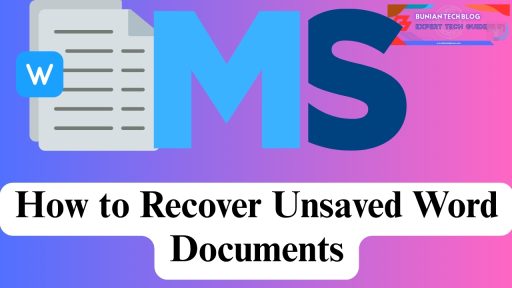We’ve all had it happen. You’re working on something important—maybe a school report, client brief, or resume—and suddenly, your computer crashes or you accidentally close the file without saving. It feels like everything is gone.
But the reality is, Microsoft Word often saves a copy of your document behind the scenes. Knowing where to look makes all the difference. Whether you’re using Word 2019, Word 2021, or Microsoft 365, there are several built-in tools and recovery options available to help you get that unsaved document back.

What is AutoRecover in Word
AutoRecover is Word’s quiet assistant. It creates a backup of your work at regular intervals. So, if your system shuts down unexpectedly, you might still have a version saved—even if you didn’t hit “Save.”
Where to Find It:
- Open Microsoft Word
- Click on File > Info
- Choose Manage Document
- Select Recover Unsaved Documents
From here, you’ll see a list of temporary files. Open the one you want, review the contents, and then save it with a new name.
Official Microsoft Guide on AutoRecover
Recovering Word Documents from Temporary Files
When Word crashes or closes abruptly, Windows may store a copy of your file as a temporary file.
How to Access Temp Files:
- Press Windows + R, then type
%temp%and press Enter. - In the folder that opens, search for file types like
.asd,.tmp, or those starting with~$. - Look for files modified around the time of your crash or unsaved exit.
- Right-click and open those files in Word.
- If you find your content, save the file immediately.
How to Find Temp Files on Windows – Lifewire
Using the Document Recovery Pane After a Crash
Sometimes, after a sudden shutdown or crash, Word automatically opens with a recovery pane on the left side of your screen.
It might show multiple versions of your unsaved document. Click through them, open each one, and compare the content. Once you find the correct version, save it.
Microsoft: Recover your Office files
OneDrive and Cloud Backup Options
If you’re saving documents to OneDrive, SharePoint, or another cloud platform, your file might have already been backed up—even if you didn’t hit “Save.”
Steps to Recover via OneDrive:
- Go to the OneDrive web interface.
- Right-click the document name.
- Select Version History.
- Review older versions and restore the one you need.
View Version History in OneDrive
Dropbox File Recovery
Recovering with “Previous Versions” in Windows
If File History or System Protection is turned on in Windows, you may be able to recover earlier versions of your document, even if you deleted it.
Windows File History Setup Guide
A Real-World Example
Lisa, a freelance writer, lost her Word document after closing the file without saving. Using the Recover Unsaved Documents feature in Word, she retrieved her content saved just minutes earlier. That small recovery setting saved her client project—and her peace of mind.
Comparing Recovery Methods: Pros and Cons
| Method | Advantages | Limitations |
|---|---|---|
| AutoRecover | Built-in and automatic | May not capture last-minute edits |
| Temporary Files | Can retrieve unsaved files | Hard to locate without experience |
| Document Recovery Pane | Easy after a crash | Won’t appear if Word closed normally |
| OneDrive / Cloud Backup | Automatically saves versions | Requires cloud sync setup |
| Previous Versions (Windows) | System-wide recovery support | Only works with File History enabled |
Word Document Recovery Success Rate
| Recovery Method | Success Rate |
|---|---|
| AutoRecover | 65% |
| Temporary Files | 30% |
| Document Recovery Pane | 50% |
| Cloud Backup (OneDrive) | 40% |
| Windows Previous Versions | 28% |
Steps to Prevent Future Data Loss in Word
- Enable AutoSave in Microsoft 365
- Change AutoRecover interval to 1 minute
- Use cloud platforms like Google Drive or Dropbox
- Activate Windows File History or use Acronis Backup
- Build a habit of pressing Ctrl + S regularly
Common Mistakes to Avoid
- Ignoring the recovery options after reopening Word
- Assuming cloud sync is automatic
- Deleting temporary files immediately after a crash
- Saving over recovered files before verifying the content
Final Thoughts
If you’re wondering how to recover unsaved Word documents, you’re not alone. But more importantly, you’re not out of options. Tools like AutoRecover, temp files, cloud backups, and system restore can help you bring back what you lost.
And by setting up backup systems today, you can save yourself a lot of worry tomorrow.
FAQ
1. Can I recover a file if I clicked “Don’t Save”?
Yes. Use Word’s Manage Document > Recover Unsaved Documents.
2. Where are temp Word files saved?
Usually in: C:\Users\YourName\AppData\Local\Microsoft\Office\UnsavedFiles
3. Is AutoRecover on by default?
Yes, but you can adjust the save interval in Word > Options > Save.
4. Can I recover deleted files from the Recycle Bin?
Yes, unless the Recycle Bin was emptied. Otherwise, try Recuva Recovery.
5. Is AutoRecover on Mac the same as on Windows?
Yes, though file paths differ: ~/Library/Containers/com.microsoft.Word/...
6. Does OneDrive automatically save?
Yes, if enabled during Word setup.
7. Can cloud platforms like Dropbox recover earlier versions?
Yes, use the Version History tool on Dropbox.
8. Is File History available in all versions of Windows?
Only in Windows 10 Pro, Home, and later.
9. Are .asd files safe to open?
Yes, they’re official Word AutoRecover files.
10. What tools can recover permanently deleted documents?
Try Recuva, Disk Drill, or EaseUS Data Recovery.





